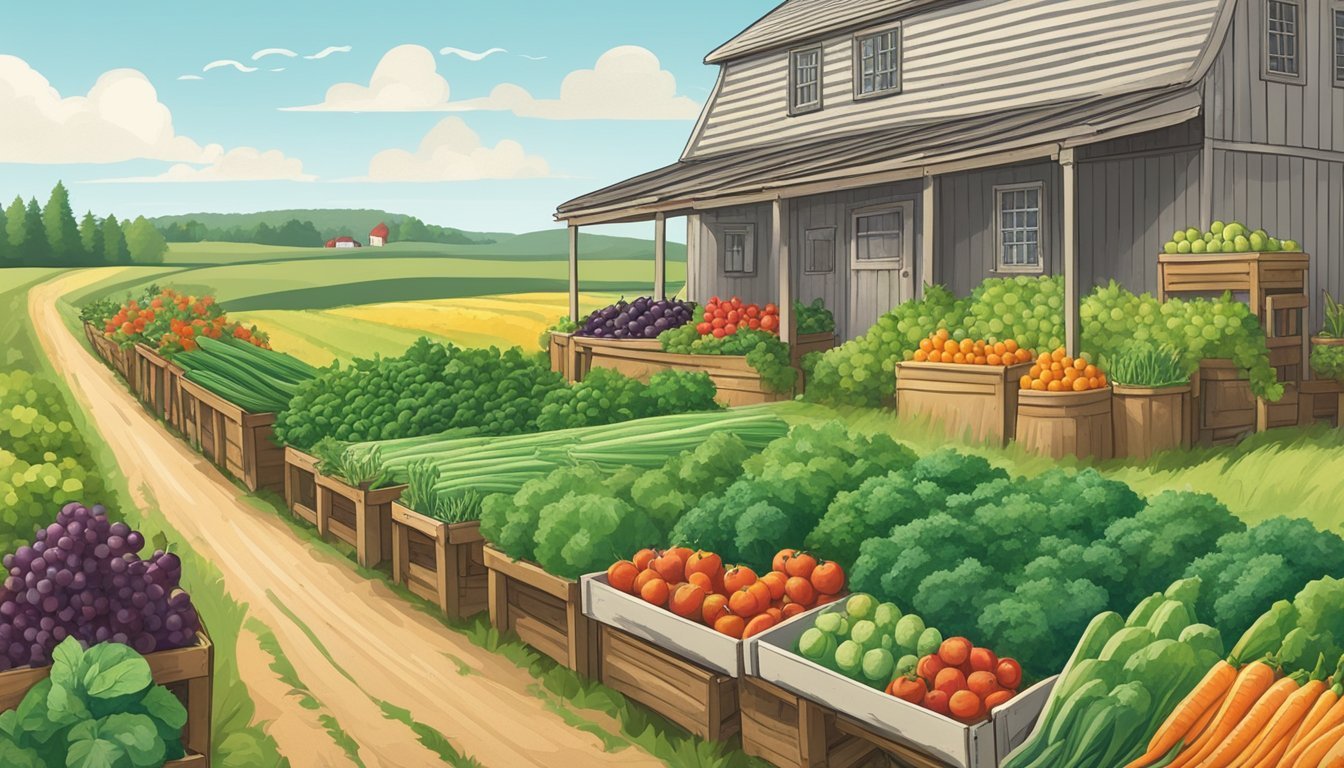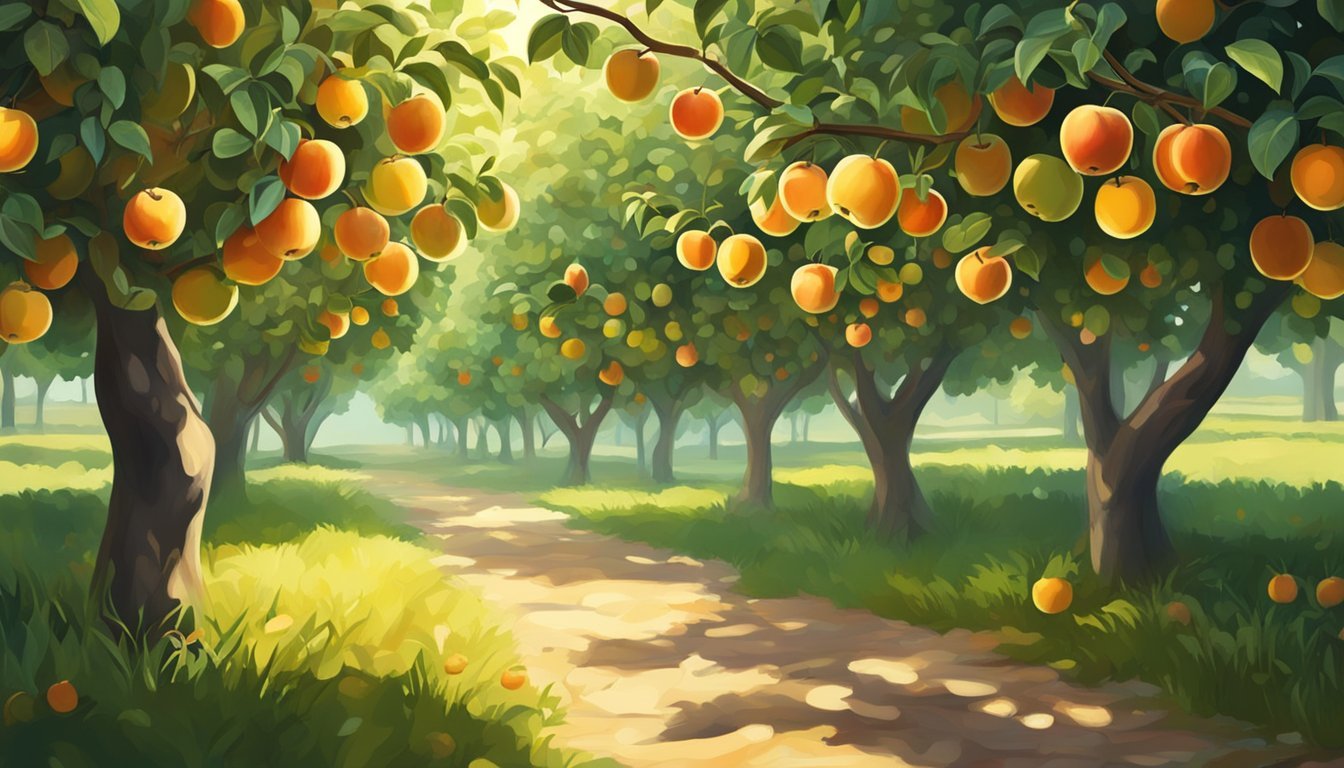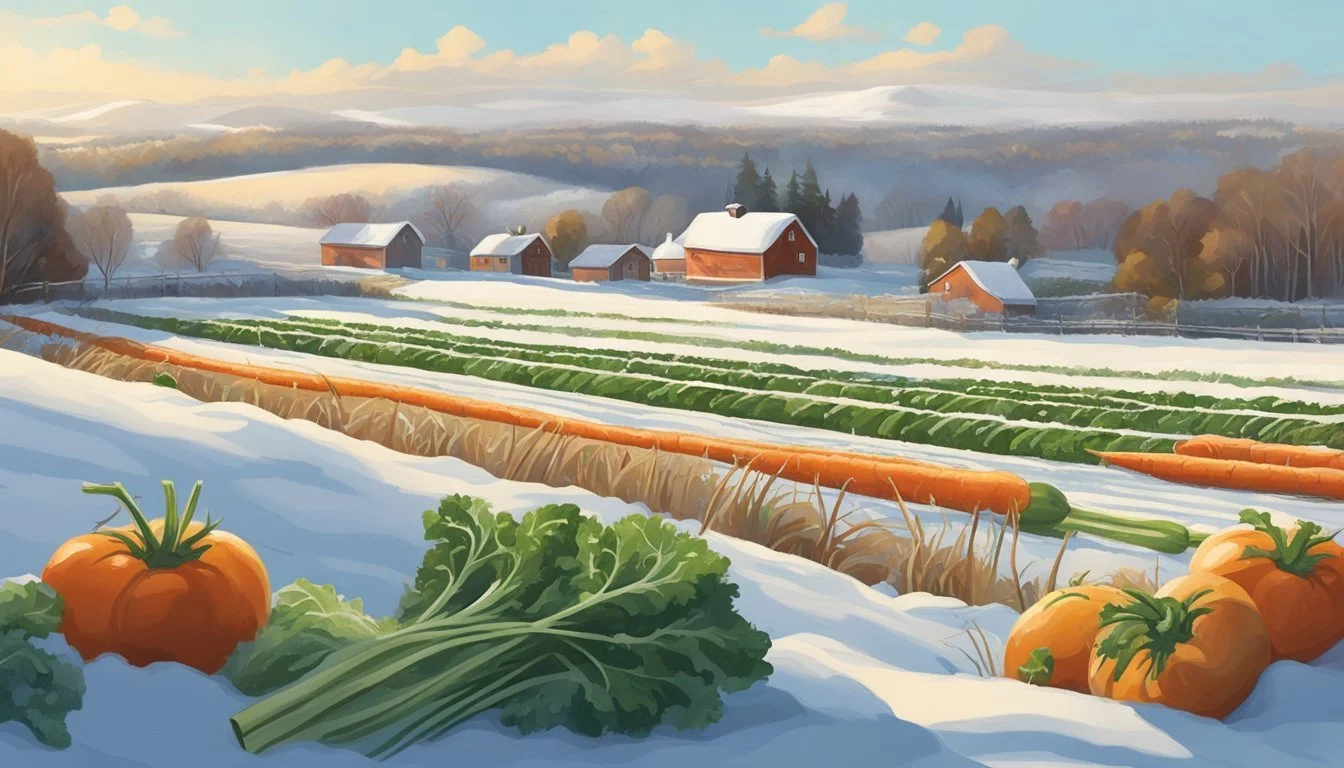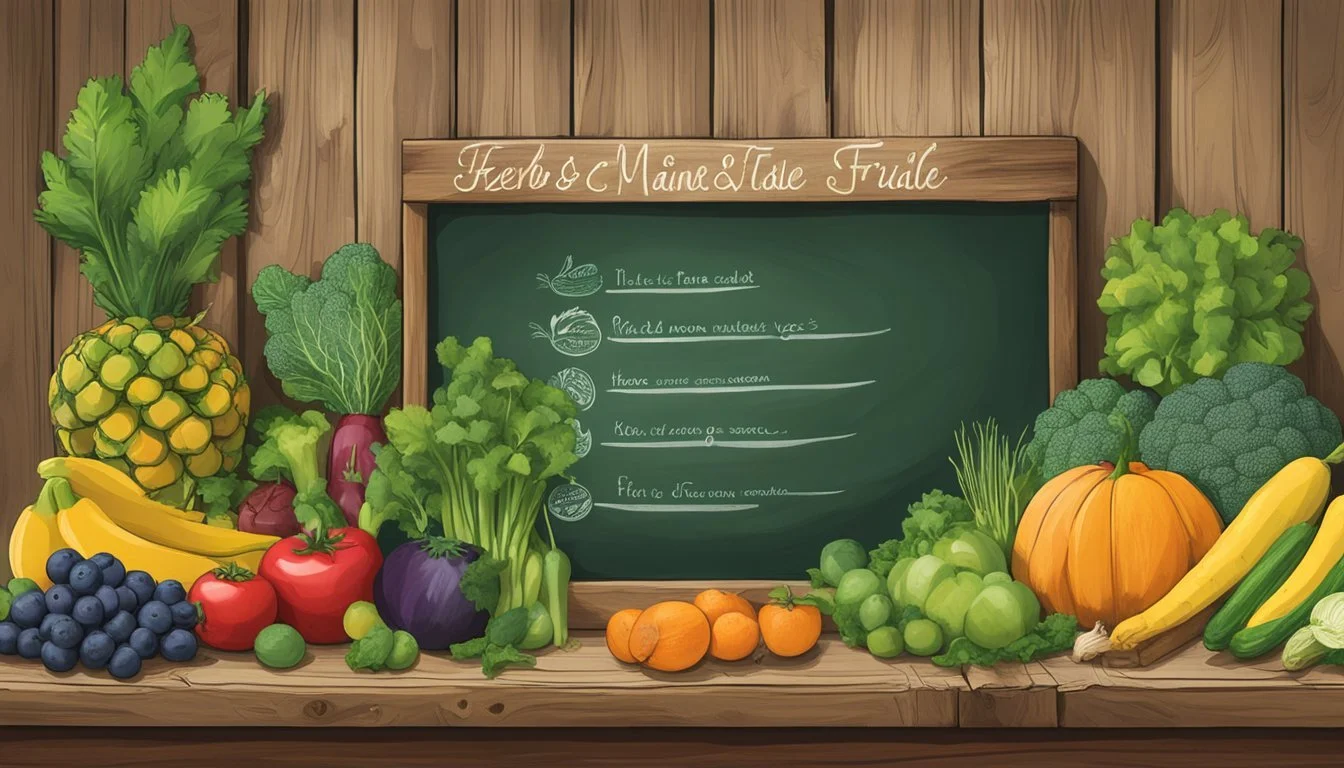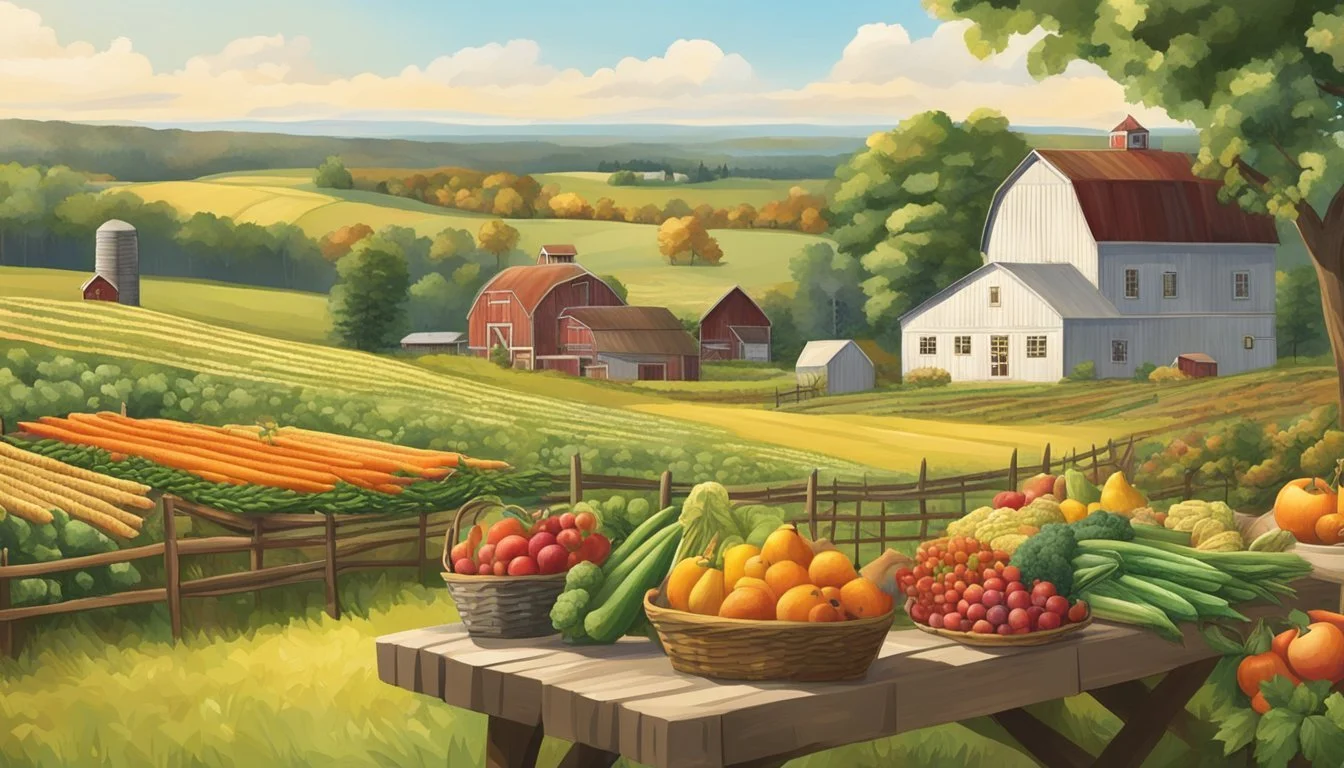Maine Seasonal Fruit & Veg Guide
Your Essential Monthly Chart
Embracing the farm-to-table movement, Maine offers an array of fruits and vegetables that shift with the seasons, providing a fresh and sustainable selection throughout the year. This guide is crafted to help consumers and chefs alike navigate the seasonal availability of Maine’s produce, ensuring the freshest ingredients are brought from the field to the table. The state’s agricultural calendar marks each season with its distinctive harvests; from the tender spears of asparagus in the spring, lush berries in the summer, to the versatile squash varieties come fall, and hearty root vegetables to carry through the winter.
Maine's geography and climate play pivotal roles in shaping its growing seasons, fostering a unique set of crops that peak at different times of the year. The guide underscores the importance of eating according to these cycles, promoting not only the nutritional benefits associated with consuming produce at its freshest but also supporting local economies. Farmers markets and local producers become focal points in this guide, as they are the nexus between Maine’s seasonal offerings and the community’s access to them.
Knowledge on Maine's seasonal produce enhances the culinary experience, guiding the creation of dishes that encapsulate the essence of each season. This guide aims to provide a comprehensive understanding of when to expect each fruit and vegetable to be at its best, facilitating a closer connection between Maine's agricultural roots and the tables around which its communities gather.
What’s in Season in Maine Right Now?
Understanding Maine's Growing Seasons
Maine's agricultural bounty is subject to the state's unique climate, offering a variety of crops that come into season at different times of the year. Interested individuals should be aware of when specific fruits and vegetables are typically available.
Spring Harvest
April and May in Maine are the bridge months where the ground begins to thaw and early spring crops make their debut. One can find:
Greens such as spinach and lettuces starting to thrive
Rhubarb typically begins to be harvestable
Summer Abundance
From June to August, Maine's farms burst into full production. This period is key for a diversity of fresher and riper produce:
June brings strawberries and peas
July is prime for blueberries, raspberries, summer squashes, and cucumbers (how long do cucumbers last?)
By August, tomatoes, corn, and green beans are at their peak
Autumn Transition
As autumn sets in from September to October, Maine experiences a rich harvest season. The foliage isn't the only thing that's abundant:
Apples and pumpkins reach maturity
Root vegetables like carrots and beets become readily available
Winter Offerings
November to December and beyond mark Winter in Maine, which brings a close to the fresh produce season. However, some hardier items remain available:
Stored root crops, such as potatoes and onions, can be found
Hoop houses and greenhouses may extend the availability of some greens
Fruits in Season
In Maine, the availability of fruit is dictated by the changing seasons, offering a diverse selection from juicy berries to crisp tree fruits. She can indulge in the freshest flavors knowing that the fruits picked at their peak will provide the best culinary experience.
Berry Varieties
Berries come into season beginning with strawberries in June, followed by blueberries, a Maine staple, peaking from late July through August. Raspberries appear in mid-summer, and as the leaves begin to turn, cranberries are harvested typically in October, signifying fall's arrival.
Strawberries: June - early July
Blueberries: July - August
Raspberries: July - September
Cranberries: October
Tree Fruits
Maine provides a variety of tree fruits with the season kicking off in summer. Cherries are among the first to appear. As summer progresses, she can expect peaches and plums, with pears ripening by late summer. Apples, Maine's signature fall fruit, have a wide season from late August through October.
Cherries: mid-June - July
Peaches: July - August
Plums & Pears: August
Apples: August - October
Melons
As for melons, they flourish later in the summer, providing a refreshing treat. Cantaloupe (how long does cantaloupe last?) and watermelon are the stars here, with their peak availability typically in the heart of summer, through August.
Cantaloupe: August - September
Watermelon: August - September
Seasonal Vegetables by Month
Maine offers a rich variety of vegetables that vary by season, allowing for a diverse and ever-changing menu throughout the year. Each season brings its own selection of fresh produce, from crisp greens to sweet root vegetables.
Spring Delights
As spring arrives, Maine's gardens begin to offer tender greens and the first harvests of asparagus. Mid-spring sees the emergence of:
Peas
Spinach
Lettuce
Summer Harvest
In the summer, vegetable gardens and farms across Maine abound with a colorful palette. This is the peak time for many favorites, including:
Tomatoes
Cucumbers
Summer Squash
Green Beans
Broccoli
Cauliflower
By late summer, early varieties of carrots and beets add sweetness and color to the table.
Fall Favorites
Autumn is the season for hearty vegetables that pair well with cooler weather. Staples during this time include:
Winter Squash
Pumpkin
Brussels Sprouts
Cabbage
Leeks
Root vegetables like sweet potatoes, parsnips, and turnips are also at their best.
Winter Staples
Even in the colder months, Maine's farms supply a range of winter staples. Hearty and flavorful vegetables available include:
Potatoes
Onions
Carrots
Celeriac
Garlic
These vegetables often store well, ensuring a supply of fresh, local produce throughout the winter season.
Herbs & More
In Maine, the farm-to-table movement not only celebrates the bounty of fruits and vegetables but also the variety of herbs and additional farm products that bring flavor and zest to any meal. Herbs grown in Maine, such as basil (how long does basil last?), chives, cilantro, dill, oregano, parsley, rosemary, and thyme, are best when harvested fresh and used to enhance the natural flavors of local dishes.
Sweet Corn and Cucumbers, staples of the Maine summer, often find companionship with a range of these aromatic herbs. The sweet, buttery kernels of corn pair beautifully with the slight licorice (how long does licorice last?) hint of basil, while the crispness of cucumbers is often complemented by the fresh, citrusy notes of dill.
Harvest times for herbs are crucial. Many herbs reach peak flavor just before flowering, and this is often when Maine farmers will harvest them for market. Savvy consumers look to purchase these at local farmers’ markets for the freshest quality and flavor.
Maine Herbs Harvest Season Basil June - September Chives May - September Cilantro June - September Dill June - September Oregano June - September Parsley May - October Rosemary May - September Thyme June - September
These herbs not only contribute to the culinary scene but also play a role in sustainable agriculture by promoting biodiversity and healthy ecosystems. They can often be found growing alongside other vegetables, supporting integrated pest management by naturally repelling certain unwanted insects. This symbiotic relationship exemplifies the thoughtful interplay between different plant species within Maine's vibrant farm-to-table system.
Local Farming and Produce
Maine's local farming and produce are essential components of the state's farm to table movement, renowned for seasonal freshness and community support.
Maine's Farmers Markets
Maine's farmers markets are vibrant community hubs where consumers can directly purchase fresh, local produce. They operate across various towns and cities, offering a seasonal array of fruits and vegetables native to the region. Farmers from around the state come together to sell their harvest, including everything from crisp apples in the fall to juicy blueberries in the summertime. These markets not only provide access to fresh, local food but also foster a direct connection between Maine farmers and consumers, which is fundamental for the sustainability of local agriculture.
Farm to Table Practices
Farm to table practices in Maine prioritize freshness, minimal transportation, and support for local economies. Farms across the state implement sustainable agricultural methods to harvest a variety of produce that is then supplied to local restaurants, schools, and households. This relationship between farms and tables ensures that Maine produce is celebrated for its quality and flavor. Season-extension techniques like greenhouses also allow for a wider variety of produce to be available beyond traditional growing seasons, bringing items such as carrots, beets, and greens to the table even during the colder months.
Seasonal Eating Tips
When approaching seasonal eating in Maine, one should be aware that the availability of fruits and vegetables changes with the months. A seasonal guide can serve as a handy reference to identify which produce is at its peak throughout the year.
January: During the colder months, options are limited; however, one can still enjoy stored root vegetables and hearty winter squashes. It's also an excellent time for making jam from preserved summer fruits.
August: The summer abundance offers a wide variety of fresh produce. This is the ideal time for tomatoes, peppers, and berries, which can be enjoyed fresh or preserved for the winter months.
November: As fall sets in, Maine provides a harvest of pumpkins, apples, and late greens. These months are perfect for preparing warming dishes with produce picked at its nutritional peak.
Here's a simple monthly breakdown for Maine produce:
Month Produce Tip January Root Vegetables, Winter Squash Perfect for soups and stews. August Tomatoes, Peppers, Berries Incorporate into salads or preserve. November Pumpkins, Apples, Greens Ideal for pies, crumbles, and hearty salads.
Eating seasonally in Maine not only supports local farmers but also ensures that individuals are consuming produce when its flavor and nutritional content is at its best. It also encourages a more sustainable food system and fosters community involvement through farm-to-table initiatives. With each season, a shift in the diet naturally occurs, offering an opportunity to diversify one's palate and discover new recipes.
Preserving the Harvest
Preserving Maine's seasonal harvest allows individuals to enjoy the taste of fresh fruits and vegetables year-round. Techniques for food preservation include canning, freezing, drying, fermenting, and more.
Canning is a reliable method to extend the shelf life of produce. Items like jams are especially popular. A basic strawberry jam recipe might involve boiling the fruit with sugar and pectin (how long does pectin last?) and then processing in a water bath canner.
Strawberry Jam:
Strawberries
Sugar
Pectin
Lemon Juice (optional)
Drying is another traditional practice, suitable for many fruits and some vegetables, turning them into convenient snacks or ingredients for later use.
For root vegetables, cellaring is an efficient storage method. Vegetables like carrots and potatoes are stored in a cool, dark, and humid environment to keep them fresh. This process mimics natural ground conditions.
Mainers are encouraged to experiment with these preservation methods:
Canning: Preserve jams, pickles, and relishes.
Freezing: Ideal for berries, beans, and corn.
Drying: Excellent for herbs and sliced apples.
Cellaring: Best for root crops like beets and turnips.
Preservation not only maintains the quality and nutrients of the harvest but also supports local agriculture by reducing food waste and enhancing food security.
Additional Local Delicacies
In Maine, a myriad of local delicacies enhances the farm-to-table experience beyond fruits and vegetables. These specialties showcase the region's agricultural diversity and culinary heritage.
Eggs: Maine's free-range eggs come from hens that roam pastures, producing rich and flavorful eggs with deep golden yolks. They are a staple in local markets, revered for their freshness and nutritional value.
Honey: With an abundance of wildflowers, Maine honey is prized for its pure, unfiltered qualities. Its flavors vary from light and floral to rich and woody, reflecting the diversity of Maine's ecosystems.
Lobster (What wine goes well with lobster?): Synonymous with Maine, lobster is a cornerstone of local cuisine. Harvested year-round with peak season in summer, Maine lobsters are known for their succulence and are a must-try coastal delicacy.
Maple Syrup (how long does maple syrup last?): Spring in Maine signals maple syrup season. Local producers tap sugar maple trees to craft syrup with robust flavors—a natural sweetener for pancakes, desserts, and glazes.
Milk: Small-scale, family-owned dairies produce milk with a focus on quality over quantity. They offer a variety of products, from whole milk to artisanal cheeses, reflecting Maine's dairy heritage.
Mushrooms: Foraged from Maine's forests or cultivated on local farms, mushrooms offer earthy flavors. Varieties like chanterelles and morels are popular among chefs and home cooks alike.
Parsley: Often found in kitchen gardens, parsley is a versatile herb used to brighten dishes with its fresh, green taste.
Salad Greens: Maine's cool climate produces crisp and tender salad greens. Varietal mixes often contain kale, arugula, and lettuce, providing a base for seasonal salads.
Garlic Scapes: These are the curly shoots from garlic plants, harvested in early summer. Garlic scapes lend a mild garlic flavor to pestos, stir-fries, and pickles. They are a seasonal treat eagerly anticipated by garlic enthusiasts.
Indulge in these local delicacies to truly appreciate Maine's farm-to-table offerings.

